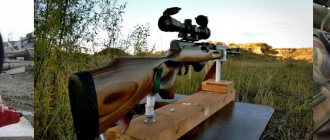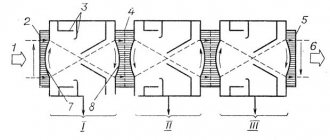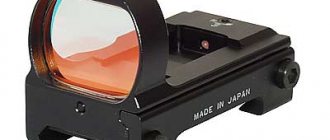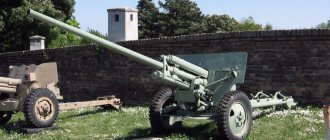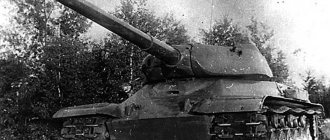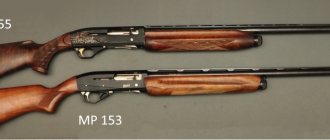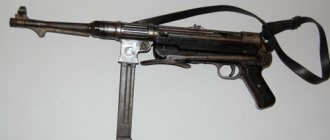- December 8, 2020
- Equipment
- Denis Serezhin
Since the time of the first hunters who used wooden spears, technology has not stood still and developed by leaps and bounds. Now almost no hunt is complete without firearms of various calibers and modifications. To make the process even more successful and fun, optical sights were borrowed from the military environment, and sighting reticles to go with them. One of the most common and convenient is the mildot reticle.
MOA (Minute Оf Angle)
In the West, this angular value is widely used in ballistics to assess the accuracy of hits, corrections when shooting, etc. By the way, we instead use another, linear value - a thousandth of the distance.
- A circle is 360 degrees;
- 1 degree is 60 arc minutes;
- The circumference is 21,600 arc minutes.
- In a circle - 2 * 3.14 radians
As you can see, the distance and diameter of the circle of hits form a triangle, solving which we will calculate the angle .
= 2 tan-1((C/2)/d), where d is the distance in inches, C is the diameter of the circle in inches
In the West, target hit groups are described in MOA because this angular width is almost exactly one inch at 100 yards, then widens out to become two inches at 200 yards, three inches at 300 yards, and so on down to 10 inches at 1000 yards.
When you say that your rifle places bullets in a 1-inch circle at 100 yards, you can also say that your rifle's accuracy is about 1 MOA (minute of arc) and this will be a more accurate characteristic because it automatically means that the rifle gives a group of hits in a circle with a diameter of 2 inches at 200 yards, 4 inches at 400, and so on.
What if your rifle hits a two-inch group at 100 yards? Simply, the coefficients are the same. Only you start counting from a wider group of hits. This "two-inch" rifle should therefore produce a four-inch group at 200 yards (twice as wide, get it?), then a 10-inch group at 500 yards, since the range is 5 times greater and the group width is also 5 times greater than 2 inches at 100 yards.
By expressing hit groups and drop in MOA, you can understand how your rifle will perform at any range. And having understood, very accurately enter corrections into the sight.
| In imported scopes, adjustments are measured in MOA. For example: Let's say your scope has one click = 1/4 MOA. You shoot at 300 yards and the bullet hits 15 inches below. We calculate the correction: 15 (inches)/3 (hundreds of yards) = 5 MOA or 20 clicks on your scope. Read more about the “price” of a sight click below. |
To make the relationship between distance and MOA clear, look at the table.
| Distance | 100 yards | 200 yards | 300 yards | 400 yards | 500 yards |
| 1 MOA equals approximately in inches | 1 | 2 | 3 | 4 | 5 |
| 1 MOA is equal to inches exactly | 1,047 | 2,094 | 3,141 | 4,188 | 5,235 |
| 1 MOA in centimeters | 2,659 | 5,319 | 7,979 | 10,639 | 13,299 |
By the way, in the West, a rifle with an accuracy of less than 1 MOA is considered a decent tool.
If, say, a carbine hits a 6cm group at 100 meters, how does that compare to their accuracy standards? The following table will help solve this issue, converting MOA into centimeters of accuracy at meter distances.
| Distance | 100 meters | 200 meters | 300 meters | 400 meters | 500 meters |
| 1 MOA is equal to, in cm | 2,9089 | 5,817 | 8,726 | 11,635 | 14,544 |
How to Convert MOA to Thousands of Distances
As we found out above, an angle of 1 MOA at 100 meters gives a circle diameter of 2.9089 cm. And 1 thousandth of a distance at 100 meters is 10 cm. Accordingly, 1 etc. greater than 1 MOA is 10/2.9089 = 3.4377 times. This is a linear relationship.
Angular ratio. If the circle of hits is 10 cm, then the angle will be equal to:
= 2 * tan-1((10/2)/(100*100)) = 2 * 0.0005 = 0.001 radian or 1 milliradian
1 milliradian = 360*60/(2*3.14*1000) = 3.4377 MOA. It is this unit of measurement (milliradians) that is used in optical sights with a Mil Dot reticle.
Duplex reticle
This is the most common type of reticle you will find among hunting rifle scopes. It is simple, concise and considered a universal grid. The thick crosshair pillars are deliberately made thin in the middle to draw the eye toward the center. It's a versatile, ideal reticle for hunting in dense woods or big game hunting where you need precision to get within range of your target, so it's no surprise that the duplex reticle is considered the best hunting reticle. Each manufacturer has a different name for this standard reticle style, such as Leupold's Duplex, Simmons' Truplex, Nikon's Nikoplex, and Weaver's Dual X.
Formula
Width or height of object (in meters) x 1000 ——————————————————————————— = Distance (in meters)
Object width or height (in mils)
or
Width or height of object (in centimeters) x 10 ——————————————————————————— = Distance (in meters)
Object width or height (in mils)
For example:
40 cm x 10 / 2 mils = 200 meters
Let's recalculate the Mil-Dot grid values into MOA, that is, convert milliradians into arc minutes. We use the formula 1 milliradian = 3.4377 MOA
You will get a picture like this
We have 223Rem caliber ammunition from the Tula plant.
And we have a table of vertical corrections in MOA of this ammunition
(Dot) Dot
Possibly one of the simplest glowing frames on the market. It consists of a closed circle and a point located in the center of the grid. It may have a crosshair emitted from above, below, to the left and to the right of it, which spreads across the entire field of view. This frame is convenient for shooting in low light or at moving targets, for example during driven hunts. The dot diameter for each scope model is indicated in minutes. The further the target is from the shooter, the more of the target the dot covers. Knowing the diameter of the point and the measured size of the target, you can estimate the distance to the target
Vertical adjustments in MOA
| Distance, meters | 0 | 50 | 100 | 150 | 200 | 250 | 300 | 350 | 400 | 450 | 500 |
| Weapon zeroed at 100 m | —- | 0,3 | 0,7 | 1,8 | 3,1 | 4,6 | 6,2 | 8,1 | 10,2 | 12,6 | |
| The weapon was sighted at 200 m | —- | -1,5 | -1,8 | -1,1 | 1,3 | 2,8 | 4,4 | 6,3 | 8,4 | 10,8 | |
| The weapon was sighted at 300 m | —- | -4,3 | -4,6 | -3,8 | -2,8 | -1,5 | 1,7 | 3,5 | 5,6 | 8,0 |
| We recalculate all this in relation to the Mil-Dot reticle and get, for example, for a weapon aimed at 100 meters such a picture | and for a weapon sighted at 200 meters, this picture |
German #4 reticle
This grid is called German ( German) number "x" regardless of the grid number. The most common and simplest of them are German #4 and German #1. You can see these reticles with thick right, bottom, and left (3, 6, and 9 o'clock) crosshairs that taper toward the center in an original style or with a dot in the center. Sometimes they come with a 12 o'clock/top crosshair and sometimes they don't. These German reticles are often backlit. Our Leupold and Meopta reviews include rifle scopes with German #4 reticles. The Zeiss Victory HT also has a similar #60 illuminated reticle.
Relative decrease in trajectory, cm
| Distance, meters | 0 | 50 | 100 | 150 | 200 | 250 | 300 | 350 | 400 | 450 | 500 |
| Weapon zeroed at 100 m | -4,0 | -0,2 | -3,8 | -12,7 | -27,8 | -50,5 | -82,7 | -127,0 | -186,4 | -264,3 |
For a distance of 250, the trajectory decrease is -27.8 cm.
Adjustment in Mils: (27.8cm x 10)/250 meters = 1.112 Mils
Sighting reticle “Christmas tree”
This type of mesh is shaped like a Christmas tree. Each subsequent hash marker on the 6-hour crosshair is longer than the previous one. These markers show wind drift corrections for correction, which is especially important at long distances.
While some of these ballistic or BDC reticles are used in hunting rifle scopes, they are more commonly found in hunting/tactical hybrid, tactical, mildot, and military rifle scopes.
MilDot Distance Chart
Usage
1. Estimate the size of the object by which you will determine the distance. Find the corresponding column in the table.
2. Measure the object in mils using the MilDot grid. Find the corresponding row in the table
3. Moving along the line until it intersects with the previously selected column, find the number that gives the distance in meters to the object
| CENTIMETERS | ||||||||||||||||||
| 15 | 20 | 25 | 30 | 35 | 40 | 45 | 50 | 60 | 70 | 80 | 90 | 100 | 120 | 140 | 160 | 180 | ||
| 3/4 | 200 | 267 | 333 | 400 | 467 | 533 | 600 | 667 | 800 | 933 | 1067 | 1200 | 1333 | 1600 | 1867 | 2133 | 2400 | |
| 1 | 150 | 200 | 250 | 300 | 350 | 400 | 450 | 500 | 600 | 700 | 800 | 900 | 1000 | 1200 | 1400 | 1600 | 1800 | |
| 1-1/4 | 120 | 160 | 200 | 240 | 280 | 320 | 360 | 400 | 480 | 560 | 640 | 720 | 800 | 960 | 1120 | 1280 | 1440 | |
| 1-1/2 | 100 | 133 | 167 | 200 | 233 | 267 | 300 | 333 | 400 | 467 | 533 | 600 | 867 | 800 | 933 | 1067 | 1200 | |
| 1-3/4 | 86 | 114 | 143 | 171 | 200 | 229 | 257 | 286 | 343 | 400 | 457 | 514 | 571 | 686 | 800 | 914 | 1025 | |
| 2 | 75 | 100 | 125 | 150 | 175 | 200 | 225 | 250 | Z00 | 350 | 400 | 450 | 500 | 600 | 700 | 800 | 900 | |
| 2-1/4 | 66 | 89 | 111 | 133 | 156 | 178 | 200 | 222 | 267 | 311 | 356 | 400 | 444 | 533 | 622 | 711 | 800 | |
| 2-1/2 | 60 | 80 | 100 | 120 | 140 | 160 | 180 | 200 | 240 | 260 | 320 | 360 | 400 | 480 | 560 | 640 | 720 | |
| 2-3/4 | 54 | 73 | 91 | 109 | 127 | 145 | 164 | 182 | 218 | 255 | 291 | 327 | 364 | 436 | 509 | 582 | 655 | |
| 3 | 50 | 67 | 83 | 100 | 117 | 133 | 150 | 167 | 200 | 233 | 267 | 300 | 333 | 400 | 467 | 533 | 600 | |
| 3-1/4 | 46 | 61 | 77 | 92 | 106 | 123 | 138 | 154 | 185 | 215 | 246 | 277 | 308 | 369 | 431 | 492 | 554 | |
| 3-1/2 | 42 | 57 | 71 | 86 | 100 | 114 | 129 | 143 | 171 | 200 | 229 | 257 | 286 | 343 | 400 | 457 | 514 | |
| 3-3/4 | 40 | 53 | 67 | 80 | 93 | 107 | 120 | 133 | 160 | 187 | 213 | 240 | 267 | 320 | 373 | 427 | 480 | |
| 4 | 37 | 50 | 63 | 75 | 88 | 100 | 113 | 125 | 150 | 175 | 200 | 225 | 250 | 300 | 350 | 400 | 450 | |
| 4-1/4 | 35 | 47 | 59 | 71 | 82 | 94 | 106 | 118 | 141 | 165 | 188 | 212 | 235 | 282 | 329 | 376 | 424 | |
| 4-1/2 | 33 | 44 | 56 | 67 | 78 | 89 | 100 | 111 | 133 | 156 | 179 | 200 | 222 | 267 | 311 | 356 | 400 | |
| 4-3/4 | 31 | 42 | 53 | 63 | 74 | 84 | 95 | 105 | 126 | 147 | 166 | 189 | 211 | 253 | 295 | 337 | 379 | |
| 5 | 30 | 40 | 50 | 60 | 70 | 80 | 90 | 100 | 120 | 140 | 160 | 180 | 200 | 240 | 280 | 320 | 360 | |
| 5-1/4 | 28 | 38 | 48 | 57 | 67 | 76 | 36 | 95 | 114 | 133 | 152 | 171 | 190 | 229 | 267 | 305 | 343 | |
| 5-1/2 | 27 | 36 | 45 | 55 | 64 | 73 | 92 | 91 | 109 | 127 | 145 | 164 | 182 | 218 | 255 | 291 | 327 | |
| 5-3/4 | 26 | 35 | 43 | 52 | 61 | 70 | 78 | 87 | 104 | 122 | 139 | 157 | 174 | 209 | 243 | 278 | 313 | |
| 6 | 25 | 33 | 42 | 50 | 58 | 67 | 75 | 83 | 100 | 117 | 133 | 150 | 167 | 200 | 233 | 267 | 300 | |
| 6-1/4 | 24 | 32 | 40 | 48 | 56 | 64 | 72 | 80 | 96 | 112 | 128 | 144 | 160 | 192 | 224 | 256 | 288 | |
| 6-1/2 | 23 | 31 | 38 | 46 | 54 | 62 | 69 | 77 | 92 | 108 | 123 | 138 | 154 | 185 | 215 | 246 | 277 | |
| 6-3/4 | 22 | 30 | 37 | 44 | 52 | 59 | 67 | 74 | 89 | 104 | 119 | 133 | 148 | 178 | 207 | 237 | 267 | |
| 7 | 21 | 29 | 36 | 43 | 50 | 57 | 64 | 71 | 86 | 100 | 114 | 129 | 143 | 171 | 200 | 229 | 257 | |
| 8 | 18 | 25 | 31 | 38 | 44 | 50 | 56 | 63 | 75 | 88 | 100 | 113 | 125 | 150 | 175 | 200 | 225 | |
| 9 | 16 | 22 | 28 | 33 | 39 | 44 | 50 | 56 | 67 | 73 | 99 | 100 | 111 | 133 | 156 | 178 | 200 | |
| 10 | 15 | 20 | 25 | 30 | 35 | 40 | 45 | 50 | 60 | 70 | 80 | 90 | 100 | 120 | 140 | 160 | 180 | |
BDC grids
This grid is named after the first three letters of the phrase Bullet Drop Compensation
(Bullet Drop Compensation) and is an aiming ballistic reticle. These reticles provide the ability to establish a true target point for a specific distance based on bullet drop. This is very useful for long range shooting. Distance markers can be hash marks, circles, or dots. The ballistic reticle can be simple and basic with a few dots or lines on the 6 o'clock crosshairs. You can check the bullet's trajectory on a vertical line with markers or using the manufacturer's online ballistics program. BDC reticles can be supplemented with special distance markings along the 3 o'clock and 6 o'clock crosshairs. It can also be complicated by Christmas tree style grid design elements, partly or across the entire field of view. Bushnell has the DOA 600 reticle with dashes instead of circles, and Weaver has the EBX reticle with etched glass.
Target click price
What is the “cost of click of a sight”? This, simply put, like any precision instrument (and a sight is one), is the price of dividing the scale marked on the vertical and horizontal correction drum. More precisely, this is the value of the angle by which the sight deviates when the drum is moved by one click or “click”. The magnitude of this angle is expressed in either MOA, thousandths of distance, or MILs.
How to find out the cost per click of a sight?
1. It is necessary to examine the instructions included with the sight, as well as the sight itself, for any clear indications of the cost per click. Quite often there are such instructions, although often the cost per click is indicated in values that are quite exotic for our country, such as “1/4 inch at a distance of 100 yards” (typical for scopes for the US market). But it can be even more mysterious when it is written, for example, “1 click=1/4″/100yds”. The problem is that the symbols for inches and arcminutes are very similar - " and ' . That is, it is clear that the cost of a click is one-fourth at a distance of 100 yards, but one-fourth of what (minutes or inches?) is easy to mistake. How much will it be in MOA? And in centimeters at a 100 meter distance? It's easy to get confused... (Answers: 0.2387 MOA and 0.7 centimeters can easily be obtained using a calculator)
In any case, whether the cost per click is indicated or not, you cannot trust it until its value is confirmed by practice.
History of creation
Mildot was originally created to meet military needs. During the First World War, a huge leap was made in the development of technology. This also affected the artillery guidance system.
The previous standard of 1° in a 360° circle no longer met the Army's needs because it was too large. Then a system of radians and milliradians was introduced, which significantly increased the accuracy of shooting.
This aiming system was appreciated and already in the 20s of the 20th century they began to be used in ground army units. True, due to the different specifics of weapons, the introduction of the mil-dot sighting reticle occurred differently in each branch of the military. Now this is reflected in the emergence of a fairly wide number of varieties of “correct” and “incorrect” mildots.
Disadvantages of FFP reticles
- Increased zoom and larger crosshairs may obscure vital points on your target
Reticle coverage on SFP reticles
SFP stands for Second or Back Focal Plane. This is the most common design that most hunters and shooters will recognize. The reticle is attached behind the magnifying lens.
When you zoom in or out, the crosshair remains the same size even though the target changes in size. As a result, the marks are constantly changing.
For example, the crosshair does not get larger as the zoom and size of the target increases, it stays the same size. If you zoom in, the target will get larger and the amount of target coverage will decrease.
The amount of space that the crosshair covers the target will continually change during the zoom process to cover less of the target area at higher magnifications.
Some FFP rifle scopes we reviewed are the Zeiss Victory HT 3-12X56, Meopta MeoStar R1r 3-12X56 RD, and NightForce SHV 5-20X56.
Advantages of SFP reticles
- The amount of reticle coverage remains thin and minimal at high magnifications
- Ideal for long-distance hunting
- Provides better insight into bullet impact on very small objects
- Improves accuracy and clarity
Disadvantages of SFP reticles
- Visibility may be difficult
- Ballistic reticle can only be used without zooming
- Ballistic reticle is unusable at any magnification
We've covered so much...
If you're still with me, it means you're truly as passionate about shooting and optics as I am - thank you.
But, a little more of your attention.
While we've covered the basics, namely what a reticle is, the different types of reticles, what they look like, and how they show your target in the field, we need to summarize all of this information to make it practical.
Here's an easy way to take a hobbyist to a pro the next time you buy a scope for the rest of your life.
Reticle coverage on FFP reticles
FFP stands for first or front focal plane. The reticle is attached in front of the magnifying lens.
As you zoom in or out, the cross threads become larger or smaller relative to the target, but the amount of coverage remains constant.
For example, the crosshair and center dot of the reticle get larger as you zoom in, and your target gets larger accordingly. The amount of space the crosshair covers the target remains unchanged.
This allows ballistic reticles to be used at any magnification as the MOA or Mrad measurements will be accurate.
Some FFP rifle scopes we reviewed are the Bushnell Elite LRHS 3-12×44 and the Vortex Optics Viper PST 6-24X50 FFP
